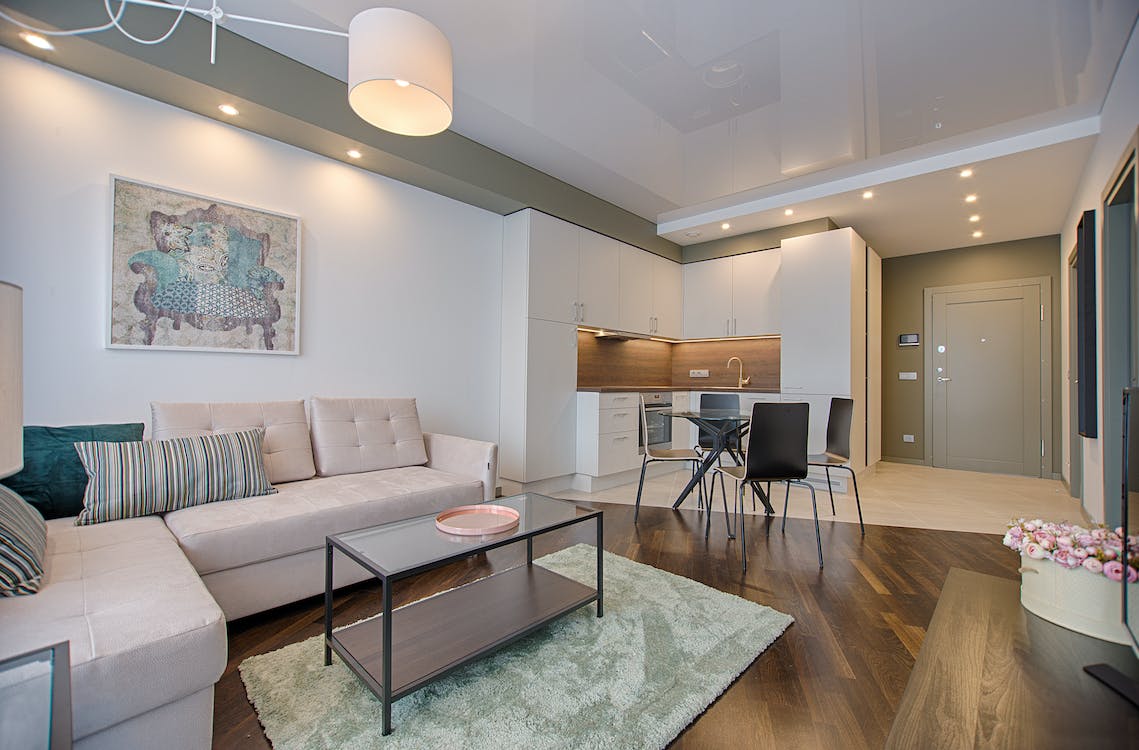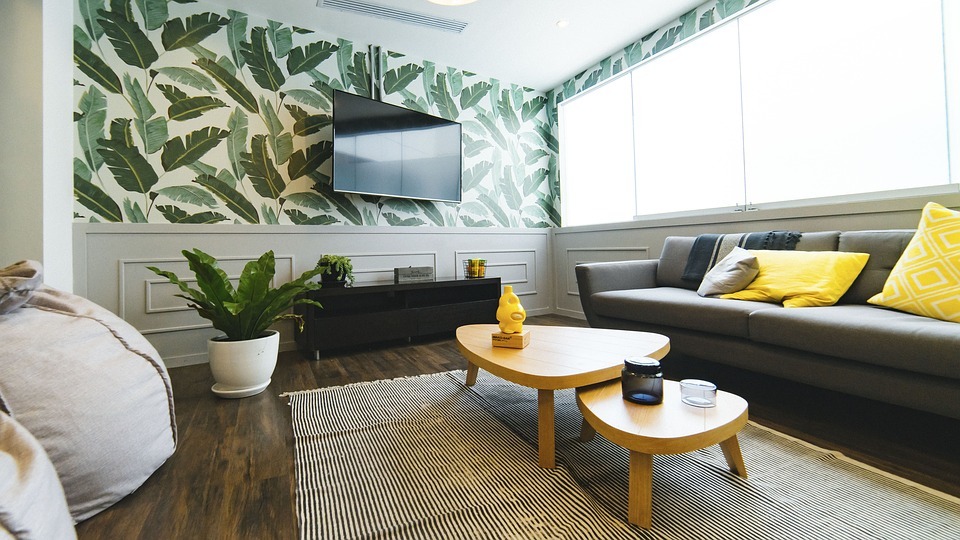People have different preferences regarding living room sizes. Some were lucky to have a wide real estate space to have a huge living room, while some were content with a small one. But not all have a choice, as some people end up in houses they didn’t even like. Regardless of size, a living room must always be functional and cozy enough for relaxation and entertaining. Plus, no matter what the size is, a living room is a place worth decorating.
Decorating a Small Living Room
A small living room might be difficult to furnish because of the lack of extra space. However, it doesn’t mean you can’t decorate – there are a lot of strategies to transform your cramped-looking living room into a cozier and pleasing living area. Here are some tips to help:
1. Maximize light.
Let in more light as much as possible. When you maximize light, you make your space look bigger. Light tricks the eyes into having more space. Keep your curtains and window treatments in light in color and weight, and keep it coordinated with the walls.
2. Choose light and neutral colors.
Lighter colors are also light in visual weight, and as a result, it opens up a room. One of the most popular ways to decorate a small living room is to use neutral colors on the walls, ceiling, floors, and furniture. Soft hues tend to illuminate the room while reflecting light. Darker woods and colors, in contrast, visually constrict the space. White walls work great with pale-colored or neutral furniture, as it makes the space look elegant and bright. It also tends to “push back” the walls.
3. Scale down furniture.
If you have a small living room, it’s logical to have scaled down furniture that will not overpower or dominate the space. Use pieces with clean lines instead of curvy ornamental pieces to save space. Go for thin legged couches, chairs, tables, and ottomans – the thin legs make the floor visible to the eyes. Prefer a sofa with thin arms and a tightly upholstered back. Opt for pale colors than darker ones. Opt for coffee tables and side tables with glass top rather than wooden ones. The key is to go for furniture pieces that obstruct less.
4. Think vertically.
Since you don’t have the luxury of a spacious interior, maximize your available vertical space. If you have a high ceiling, decorate it in a way that draws the eyes upward. Make people look above the floor level by adding decorations like a tall and simple floor lamp or a simple pendant light. Place full-length curtains on windows. Add open vertical shelving to store your books and other decorations. If you have a low ceiling, paint your walls with vertical stripes to make the room seem higher.
5. Opt for multi-purpose furniture.
Making furniture multi-functional is a practical thing to do when dealing with smaller spaces. Go for a corner banquette with storage underneath the seats. Choose a coffee table that has additional storage space, or you can just place an oversized ottoman in the center so it can also serve as extra seating when hosting more people. Get a couch that can transform into a bed so you can give your guests a comfortable place to stay overnight.
6. Look for portability.
Portable pieces are easy to move, giving you flexible choices for your space. For instance, you can get a couple or three small end tables you can easily attach together to create a coffee table when you have guests, but you can also scatter to corners to open up space for children to play or for you to do your home workout. This makes a practical solution if you’re really short on space.
7. Go bold and glamorize.
Don’t ever think that you should refrain yourself from decorating when you have a small living room. Bring in pops of bright and dramatic color in contrast to your pale and neutral furnishings to make spaces seem larger. Make statement pieces with your wall art, cushions and rugs to make your living room cheerful.
8. Add greenery.
Nothing beautifies a living room like plants. Get leafy ferns and spider plants to bring texture to your space and clean air indoors. Flowering plants like daffodils and tulips add pretty pops of color to your room. But if you think you can’t maintain plants, then try succulents like cactus. Some of them even bear flowers, which makes them cuter.
9. Add mirrors.
Mirrors are often strategically placed in small places to make the room look larger as it reflects the same space. Hang a large mirror in a center of a wall or a furniture arrangement to create an automatic focal point.
Decorating a Large Living Room
A large living room might be easier to decorate than a small one. But a very large room can also be challenging to decorate just like a small one – but it’s truly a great challenge to have! It’s also more fun to do since you have a wider variety of choices in regards to colors and furniture. Check out these tips:
1. Use colors.
When decorating a large room, it is good to introduce different colors – but not too many colors – since you already have the space. As stated earlier, a big living room gives you the liberty to either go dark, go bold, go neutral or go warm when it comes to colors because all of them can add a cozy feeling since the space is huge. Just add contrast and interest with your choice of the color palette so your space would look more inviting and pulled together. For instance, you may choose warm whites as the main color of the room, but you can give a dark color like black for furnishings or dark wood accents. And then, you may balance it with bright and bold accent colors to enhance space and add a vibrant effect. It’s always best to keep a large furnishing in a neutral or muted color unless you are really going for a bold interior style.
2. Make colors and architectural details work together.
Colors and patterns can be used to visually cut and break down big expanses of walls that can be overwhelming. Large rooms with one plain color might seem distant and incomplete. Consider adding architectural elements such as moldings or columns to enhance your large space. Add wainscoting in white or a neutral color. Create an accent wall using paneling. This makes the room feel more smug and cozy.
3. Consider the scale.
Before you go shopping for furnishings, consider the scale of your room first. A large room calls for bigger furniture, but also check out the height. If your room has a tall ceiling, opt for taller furniture like sofas and chairs with longer legs and tall backs, tall bookcase or other tall accessories like vases and lamps. Low furniture against a tall wall may look dwarfed and lost in space. But if your ceiling is low, then do otherwise.
4. Create zones.
Making a large living room serve just as a conversation area might not seem inviting enough. If you have to shout at another just for them to hear you, then your furniture arrangement is spaced too away from each other. It helps to designate zones to create individual spaces that work together as one. Don’t just settle for having one large sitting area – you’re lucky enough to have the space, so make the most out of it! Identify different possible functions for your living room. By strategic placement of furniture, you can have a conversation area (or even two or more), a media zone where your family can watch TV, a console or game table, a reading nook, and a desk area for work.
5. Visually divide the space.
Now, in defining your zones, you don’t only strategically place furniture. Break up the space with dividers. Rugs really help in defining your zones in terms of floor space, and wallpapers in terms of wall space. You may use dividers like a panel divider, half walls or columns, or just place furniture like open bookshelves or credenza to create smaller spaces within a larger room. A sofa with its back turned to another space, tables between chairs and a large bench also works as visual dividers.
6. Anchor the room.
Creating areas or zones within the room might make the living room look cluttered, so don’t forget to put distinguishing anchor pieces. It can be a huge and attractive bookcase, a fireplace, a large coffee table or an oversized artwork. The key is to have one large central feature that would serve as the main focal point of the room. But if you want to decorate with a smaller collection of items, remember to group them in threes, like three vases grouped together. The eyes will consider them as a whole.
7. Keep furniture away from the walls.
Avoid pushing furniture against the walls as it leaves a lot of space in the middle open. Seating is better pulled away from the walls and around the focal point, plus it keeps the feet of your furniture sit in an area rug, making a cozier conversation area. Too much space within seating might feel awkward. Just decorate your empty walls with beautiful wall art or accessories to bring a beautiful ambiance.
8. Use creative lighting.
The perks of having a large living room are that you can be extra with lighting. Large living rooms often have tall or large windows, so daylighting is very accessible. But during the night, one center light won’t be enough, especially if you have created more than two zones. You may even pick a big, bright and beautiful chandelier, but still, create shadows on some corners. Add wall and desk lamps as needed, as these pieces can serve as decoration as well. But don’t overdo it though – too many lamps can make the room look awkward.
9. Be bold.
For a large room with too much space to spare, the bigger and the bolder, the better. Break up the monotony of a very large wall by putting an oversized artwork hung on the wall, or an impressively huge functional sculpture or a personalized chimney flue. You may also group large art pieces together on a tall wall. Use bold draperies that flow up to the floor for that grand, bold and regal effect.



